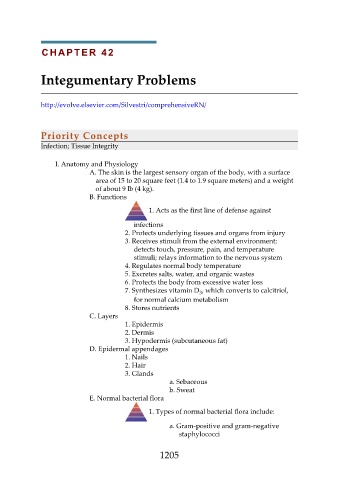Page 1205 - Saunders Comprehensive Review For NCLEX-RN
P. 1205
CHAPTER 42
Integumentary Problems
http://evolve.elsevier.com/Silvestri/comprehensiveRN/
Priority Concepts
Infection; Tissue Integrity
I. Anatomy and Physiology
A. The skin is the largest sensory organ of the body, with a surface
area of 15 to 20 square feet (1.4 to 1.9 square meters) and a weight
of about 9 lb (4 kg).
B. Functions
1. Acts as the first line of defense against
infections
2. Protects underlying tissues and organs from injury
3. Receives stimuli from the external environment;
detects touch, pressure, pain, and temperature
stimuli; relays information to the nervous system
4. Regulates normal body temperature
5. Excretes salts, water, and organic wastes
6. Protects the body from excessive water loss
7. Synthesizes vitamin D , which converts to calcitriol,
3
for normal calcium metabolism
8. Stores nutrients
C. Layers
1. Epidermis
2. Dermis
3. Hypodermis (subcutaneous fat)
D. Epidermal appendages
1. Nails
2. Hair
3. Glands
a. Sebaceous
b. Sweat
E. Normal bacterial flora
1. Types of normal bacterial flora include:
a. Gram-positive and gram-negative
staphylococci
1205

